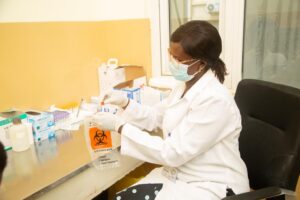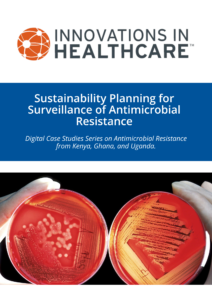
Antimicrobial resistance (AMR) is a significant global public health menace.
When antimicrobials are ineffective against previously treatable infections, it undermines the ability of health systems around the world to treat even minor infections, resulting in more expensive treatments, and excess mortality and morbidity when infections become untreatable. A recent study on the burden of AMR estimates nearly 5 million deaths associated with bacterial AMR in 2019, with 1.3 million deaths attributable to bacterial AMR 1, suggesting that AMR is at least as large as HIV and malaria.
Of all the regions, Sub-Saharan Africa has the highest mortality rate from bacterial AMR at 27.3 deaths per 100,000.1 This high burden is exacerbated by a shortage of trained professionals and limited microbiology laboratory capabilities. In fact, only 1.3% of the 50,000 medical laboratories in 14 African countries conduct bacteriology testing, which severely restricts the availability of population-level AMR data.2 This lack of data hinders the development of effective interventions to combat AMR.
The SPIDAAR Initiative
Recognizing the urgent need for improved AMR surveillance in Africa, Pfizer Inc., Wellcome Trust, and the Ministries of Health in Ghana, Kenya, Malawi, and Uganda launched the Surveillance Partnership to Improve Data for Action on AMR (SPIDAAR). This pilot public-private partnership aims to enhance AMR surveillance capacity by training clinical and microbiological staff in eight hospitals across the four countries to perform diagnostic testing on 100 isolates per site for five key pathogens.
improved AMR surveillance in Africa, Pfizer Inc., Wellcome Trust, and the Ministries of Health in Ghana, Kenya, Malawi, and Uganda launched the Surveillance Partnership to Improve Data for Action on AMR (SPIDAAR). This pilot public-private partnership aims to enhance AMR surveillance capacity by training clinical and microbiological staff in eight hospitals across the four countries to perform diagnostic testing on 100 isolates per site for five key pathogens.
The SPIDAAR initiative focuses on creating systems and methodologies to collect, process, and analyze cultures from inpatients. These samples were then sent to the National Institute for Communicable Diseases (NICD) in South Africa for confirmation, allowing for accurate analysis of AMR trends and feedback on the reliability of hospital culture results.
Sustaining AMR Surveillance: The Role of Innovations in Healthcare
 In May 2021, Pfizer Inc. enlisted Innovations in Healthcare (IiH) to support the sustainability of SPIDAAR’s efforts. Over two years, IiH provided resources and guidance to four African country AMR teams within the Ministries of Health and at SPIDAAR sites. This collaboration led to the development of a sustainability framework outlining essential elements for a robust AMR surveillance system, accompanied by a checklist to guide teams towards long-term sustainability.
In May 2021, Pfizer Inc. enlisted Innovations in Healthcare (IiH) to support the sustainability of SPIDAAR’s efforts. Over two years, IiH provided resources and guidance to four African country AMR teams within the Ministries of Health and at SPIDAAR sites. This collaboration led to the development of a sustainability framework outlining essential elements for a robust AMR surveillance system, accompanied by a checklist to guide teams towards long-term sustainability.
Using quality improvement principles, IiH designed and deployed a tool to assess the progress of site and national AMR teams. Additionally, peer learning and collaboration sessions were facilitated to address common challenges and share strategies for overcoming them. While progress varied among sites, notable advancements were documented in several locations.
Case Studies: Lessons from Ghana, Kenya, and Uganda
 To provide actionable insights, IiH developed a case studies series on the experiences of AMR teams in Ghana, Kenya, and Uganda. These case studies, based on desk reviews and in-depth interviews, illustrate the implementation of AMR surveillance through SPIDAAR, the challenges faced, and the strategies employed to address them.
To provide actionable insights, IiH developed a case studies series on the experiences of AMR teams in Ghana, Kenya, and Uganda. These case studies, based on desk reviews and in-depth interviews, illustrate the implementation of AMR surveillance through SPIDAAR, the challenges faced, and the strategies employed to address them.
Each case study serves as a reference for other AMR teams in low-resource settings, detailing the steps needed for systematic AMR surveillance and highlighting areas requiring further attention for sustainable implementation. These experiences offer valuable lessons for Ministries of Health, development partners, and health facility leaders aiming to strengthen AMR surveillance capabilities.
[1] Global burden of bacterial antimicrobial resistance in 2019: a systematic analysis; https://doi.org/10.1016/ S0140-6736(21)02724-0
[1] Incomplete antimicrobial resistance (AMR) data in Africa: The crisis within the crisis; September 2022, Policy Brief, African Society for Laboratory Medicine (https://aslm.org/resource/policy-brief-and-infographics-on-antimicrobial-resistance-amr-in-africa/, Accessed 20 April 2023).
